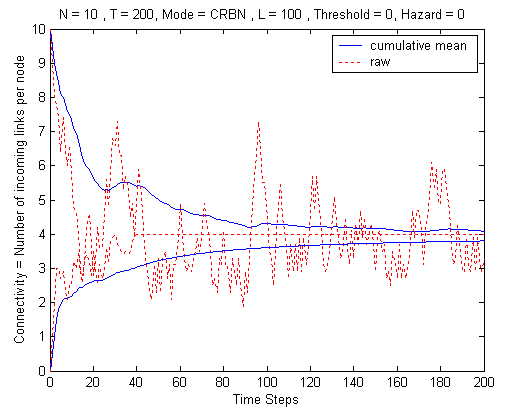| |
evolveTopology()
Evolve and display topology according to algorithm described by Christof Teuscher and Eduardo Sanchez
in "Self-Organizing Topology of Turing Neural Networks" ([SP4]). Make sure to use a fully connected network (N=K)!
Syntax
[nodeUpdated, fHandleOut, kav, meankav] =
evolveTopology(node, mode, tSteps, initialK, hazard)
[nodeUpdated, fHandleOut, kav, meankav] =
evolveTopology(node, mode, tSteps, initialK, hazard, fHandleIn)
[nodeUpdated, fHandleOut, kav, meankav] =
evolveTopology(node, mode, tSteps, initialK, hazard, runLength, threshold)
[nodeUpdated, fHandleOut, kav, meankav] =
evolveTopology(node, mode, tSteps, initialK, hazard, fHandleIn, runLength,
threshold, tMax))
Description
evolveTopology(node,
mode, tSteps, initialK, hazard) evolves
node in mode update-scheme over tSteps discrete time-steps with numbers of connections per node initially set to
initialK. Paramters of algorithm: runLength is set to n (number of nodes), threshold to 0 and tMax to infinity.
hazard defines the number of randomly added/removed connections per time-step.
evolveTopology(node,
mode, tSteps, initialK, hazard, fHandleIn) evolves
node in mode update-scheme over tSteps discrete time-steps with numbers of connections per node initially set to
initialK. The graph is plotted in the figure window referenced by
fHandleIn. Paramters of algorithm: runLength is set to n (number of nodes), threshold to 0 and tMax to infinity.
hazard defines the number of randomly added/removed connections per time-step.
evolveTopology(node,
mode, tSteps, initialK, hazard, runLength, threshold) evolves
node in mode update-scheme over tSteps discrete time-steps with numbers of connections per node initially set to
initialK, using runLength and threshold as parameters for the algorithm. tMax is set to infinity.
hazard defines the number of randomly added/removed connections per time-step.
evolveTopology(node,
mode, tSteps, initialK, hazard, fHandleIn, runLength, threshold,
tMax) evolves node in mode update-scheme
over tSteps discrete time-steps with numbers of connections per node initially set to
initialK, using runLength, threshold and tMax as parameters for the algorithm. The graph is plotted in the figure
window referenced by fHandleIn. hazard defines the number of randomly added/removed connections per time-step.
Input:
node - 1 x n structure-array containing node information
mode - String defining update scheme. Currently supported modes are:
CRBN, ARBN, DARBN, GARBN, DGARBN
tSteps - Number of time steps to run (Parameter T)
initialK - Initial value for connectivity
hazard - Number of randomly (not according to evolution rule) added/removed connections per time-step
fHandleIn - (Optional) Handle to figure window
runLength - (Optional) Length of 'activity measuring' (Parameter L)
threshold - (Optional) Activity threshold
tMax - (Optional) Maximal number of time steps to search for attractor
Output:
nodeUpdated - 1 x n sturcture-array with updated node information
("lineNumber", "state", "nextState")
fHandleOut - Handle to figure window
kav - Average connectivity for each time-step (raw)
meankav - Cumulative average connectivity for each time-step
Example
The following commands evolve a
CRBN network's topology over 200 time-steps starting first from
initial connectivity set to N=10 and then starting from initial
connectivity set to 0. The handle of the figure is used to display
both evolutions in the same window.
The parameters hazard, runLength, threshold and tMax are set to 0,
100, 0 and infinity respectively.
Please note that you have to use a fully connected network
(N=K=10) in order to be able to start the topology evolution with
an initial connectivity of 10!
>> [node, conn, rule] = bsn(10,10,'line');
>> [node, myHandle, kav, meankav] = evolveTopology(node,'CRBN', ...
200,10,0,100,0);
>> [node, myHandle, kav, meankav] = evolveTopology(node,'CRBN',200, ...
0,0, myHandle,100,0,inf);

See also
evolveARBN(),
evolveDARBN(), evolveGARBN(),
evolveDGARBN(), evolveCRBN(),
findAttractor(), countTransitionsPerNode()
|
|